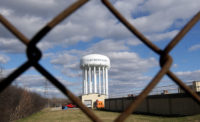The owner of a dam that failed May 19 in north central Michigan had its power-generation license revoked by Federal Energy Regulatory Commission in September 2018 after more than a decade of negotiations with the energy regulator.
The main concern cited by FERC at the time was that the dam’s spillway would not be able to withstand a major flood.
The Edenville Dam on the Tittabawassee River in north central Michigan failed about 6 p.m. Eastern time on May 19.
The failure led to the subsequent overtopping of the Sanford Dam downstream. The inundation forced the evacuation of 10,000 people in Midland County. Heavy rain across the area pushed the Tittabawassee over its major flood stage at 28.25 ft on the morning of May 19. It had reached a record 34.6 ft by the afternoon of May 20. The river’s flood stage is 24 ft.
FERC had notified the dam’s previous owner as far back as 1999 that it needed to increase the Edenville spillway capacity to prevent a significant flood from overwhelming the structure.
Boyce Hydro, Edenville Dam’s owner, argued in legal filings and correspondence with FERC that revoking the power-generation license would make it harder to sell the dam.
Boyce Hydro and the Sanford Lake Association, a local consortium that sought to buy the dam, argued that ongoing litigation with the Michigan Dept. of Environmental Quality over permits to construct more spillway capacity was hampering maintenance, and that revoking the license would eliminate the only source of revenue to pay for repairs and upgrades.
Boyce Hydro also argued in 2018 that the “odds of a ‘probable maximum flood’ event occurring in the next five to 10 years is five to 10 in one million,” according to FERC records.
The Edenville Dam was completed in 1925 and was capable of generating 4.8 MW of power. FERC had cited Boyce for, among other things, making unauthorized repairs, unauthorized earth moving, failure to file proper safety plans, failure to provide recreational areas and public access, failure to secure necessary property rights and failure to comply with water-quality orders. Boyce Hydro did not immediately return ENR’s calls to its Midland office for this story.
“For over 14 years, the commission has gone to great lengths to compel compliance with the license requirements, and Boyce Hydro has delayed, disregarded its responsibility and claimed that it was not financially capable of meeting such requirements. Meanwhile, Boyce Hydro continued to benefit from the revenues generated by the project,” the commission wrote.
FERC Chairman Neil Chatterjee said in a May 20 statement that the regulator is following the news and will direct Boyce Hydro to begin an investigation of what caused the failure after the emergency ends.
“When it is appropriate and safe to do so, FERC will send a staff engineer to the site to assist with the investigation,” Chatterjee said. “The commission pledges to work closely with state officials and coordinate our investigatory efforts wherever possible.”
Michigan Gov. Gretchen Whitmer [D] said in a May 19 news conference: “This is unlike anything we’ve seen in Midland County. To go through this in the midst of a global pandemic is almost unthinkable.”
State of Emergency
Whitmer declared a state of emergency in Midland County on May 19, and the Michigan National Guard has been responding to it, along with the Federal Emergency Management Agency, the governor said. Evacuation orders included parts of Midland, Edenville and Sanford. Shelters for residents seeking higher ground have been opened at three local high schools and a family center.
President Donald Trump said he would visit Michigan to assess damage, and that the U.S. Army Corps of Engineers would assist local authorities in emergency repairs.
“I just spoke with Gretchen Whitmer. I will be going to Michigan at the appropriate time,” Trump said, according to a White House press pool report. “They have a big problem with the dams breaking. And so we’ve sent FEMA and the Army Corps of Engineers out."
Dow Chemical’s global headquarters, a chemical production complex and the manufacturer's vast Superfund toxic waste cleanup site are located in Midland along the Tittabawassee downstream from the floods.
“Dow’s local emergency operations center is fully activated and is implementing its flood preparedness plan. All operating units on site have been safely shutdown, except for facilities needed for safely managing chemical containment, and all railcars are secured,” Dow Chemical said in a statement.
“At approximately 10 a.m. Eastern [May 20], it was confirmed there were flood waters commingling with on-site containment ponds. We immediately partnered with the U.S. Coast Guard to activate emergency plans,” the Dow statement said.
The Superfund sites are downriver from the plant and company headquarters.






Post a comment to this article
Report Abusive Comment